A Pioneer of Heavy Lift Shipping
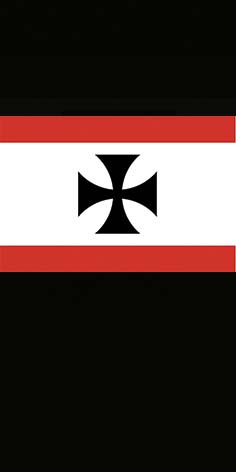
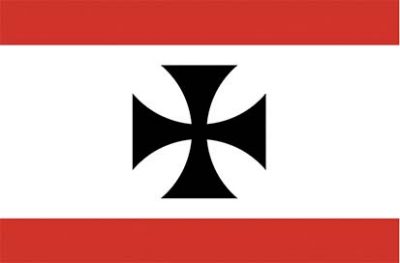 Hansa Line was the first shipping company in the world to introduce a cargo-liner in 1929 with a derrick capable of lifting 120 tonnes. This was a technical sensation at the time as all derricks were of small lifting capability, notably from two tonnes to a twenty tonner if the shipowner thought there might be a need for heavy lifting. By 1968, Hansa Line of Bremen operated a very big fleet of 46 cargo-liners, of which thirty were heavy lifters, and the ‘champion’ heavy lifter Uhenfels had just been introduced equipped with two sets of lifting gear each of 275 tonnes capability. When used in tandem, this gear could lift 550 tonnes in a straight lift of heat exchangers, oil and gas refinery modules, and pressure towers that the modern industrial world needed badly to bring new projects online across the world. Hansa Line at its formation in 1881 incorporated the same tradition of ‘Hansa’ merchants and shipowners working together in unions and guilds that the Hanseatic League had previously used for seven centuries.
Hansa Line was the first shipping company in the world to introduce a cargo-liner in 1929 with a derrick capable of lifting 120 tonnes. This was a technical sensation at the time as all derricks were of small lifting capability, notably from two tonnes to a twenty tonner if the shipowner thought there might be a need for heavy lifting. By 1968, Hansa Line of Bremen operated a very big fleet of 46 cargo-liners, of which thirty were heavy lifters, and the ‘champion’ heavy lifter Uhenfels had just been introduced equipped with two sets of lifting gear each of 275 tonnes capability. When used in tandem, this gear could lift 550 tonnes in a straight lift of heat exchangers, oil and gas refinery modules, and pressure towers that the modern industrial world needed badly to bring new projects online across the world. Hansa Line at its formation in 1881 incorporated the same tradition of ‘Hansa’ merchants and shipowners working together in unions and guilds that the Hanseatic League had previously used for seven centuries.
THE HANSEATIC LEAGUE
The Hanseatic League was a commercial union between several German ports including Hamburg, Lubeck, Bremerhaven and Rostock from the twelfth century onwards. It controlled the Baltic and North Sea trades for centuries by having satellite trading houses called ‘Kontors’ (towns within towns), in ports such as London, Bergen and Bruges. The British east coast ports of Newcastle, Berwick, Leith, Hull, York, Great Yarmouth and King’s Lynn also participated in the Hanseatic League trades with some permanent ‘Hansa’ traders domiciled there. The earliest written reference to the Hanseatic League dates back to 1159 when the merchants of Lubeck had already been trading through the Oresund to Bergen for decades for dried codfish, butter, furs and axes from Bergen in return for foodstuffs from the Baltic Sea countries. This was in the form of a footnote regarding Hanseatic League trading in the account of the rebuilding of Lubeck in that year by the powerful Henry the Lion, Duke of Saxony.
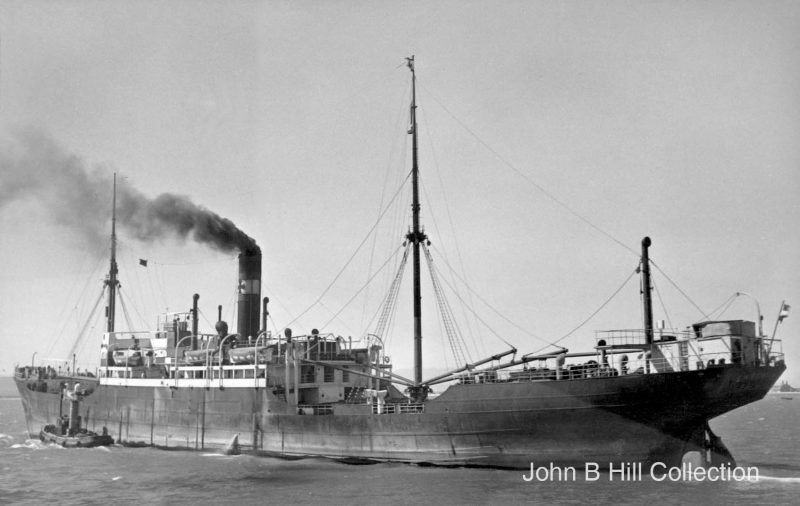
German cities achieved dominance of the trade with the Baltic area with striking speed in the twelfth and thirteenth centuries, and Lubeck became a central node in the seaborne trades of the North Sea and Baltic Sea. There were nine Hanseatic League port members that attended the last formal meeting of the Hanseatic League in 1669, but only three (Lubeck, Hamburg and Bremen) remained as members until its final demise in 1862, with the creation of the German Empire under Kaiser Wilhelm I. The Hanseatic League had maintained their powerful dominance of these trades for centuries, mostly by the use of the ‘Kontor’ towns within towns that were not short on the use of various forms of pressure being applied to native merchants of the ‘Kontor’ towns to increase their trade. The Hanseatic League was not a national German movement, but rather a commercial union or cartel of ports that upheld their tough and unsentimental commercial rights to these trades. A ‘Hansa’ thus means a powerful union or guild, and this name was used for two Transatlantic liners owned by Hapag.
HANSA D.D.G. (HANSA LINE)
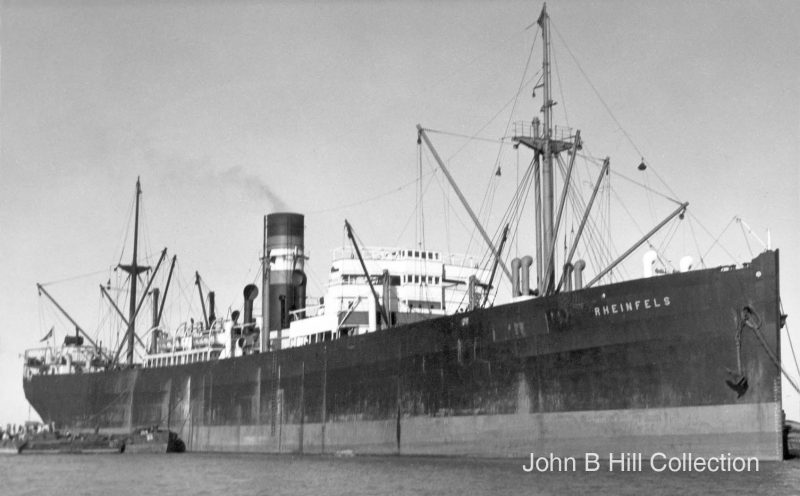
Hansa Deutsche Dampfschiffarts Gesellschaft (Hansa German Steamship Company) was a major German liner company specialising in heavy lift shipping to the Persian Gulf and India. It continued the notions of the Hanseatic League two decades after its demise by being founded by a ‘constituent general assembly’ in Bremen on 3rd December 1881 of a consortium of seventeen Bremen and two Bremerhaven shipping companies. The first steamship was immediately ordered from the Newcastle yard of Charles Mitchell & Company (as Yard number 419) and was completed in February 1882 as Stolzenfels of 2,328 grt. She was equipped with three square sails on the foremast and others on the mainmast as insurance on the long maiden voyage to Singapore from the Tyne. After two years of service, she was lost in collision with the British steamer Canton while anchored in Saigon Roads with a cargo of rice on 10th May 1884.
Regular steamship services to the Baltic and Mediterranean countries were operated by seven steamers in 1883, but Oltmann Johan Dietrich Ahlers, the first head of the company, soon withdrew from the Baltic trades and limited the Mediterranean trade to Spain and Portugal using Soneck of 834 grt. The deep sea trades prospered however, with many new steamers e.g. Ehrenfels of 2,315 grt in 1882 and rebuilt to 2,958 grt in 1892, Drachenfels of 2,251 grt in 1882 and rebuilt to 2,432 grt in 1892, Trifels of 2,766 grt in 1888, Gutenfels of 2,675 grt in 1889, Rheinfels of 2,717 grt in 1889, Ockenfels of 3,589 grt in 1995, Goldenfels of 3,535 grt in 1895, and Hohenfels of 5,469 grt in 1998. The fleet brought back imported cotton, jute and rice from India, the Middle East and Far East.
The Hansa fleet had reached the size of a big deep sea fleet of over forty ships with more on order by the turn of the century. Services were also run to South America and the River Plate, and later in 1901 to the U.S. Gulf for cotton homewards and a North American service via South Africa to India, which was extended in 1907 to the Dutch East Indies and Australia. In 1910, Ahlers was succeeded as Chairman of the Board of the company by Hermann Helms (1868-1942), and four years later on the onset of World War I, Hansa D.D.G. had a large fleet of 67 ships of a total size of 437,789 grt. This fleet had suffixes of ‘Fels’, ‘Burg’, ‘Eck’, and ‘Turm’ (Rock, Fort, Crag, Tower) to their names, names that were easily recognised as belonging to the third largest German shipping company and only eclipsed by the German shipping companies of Hapag and Norddeutscher Lloyd.
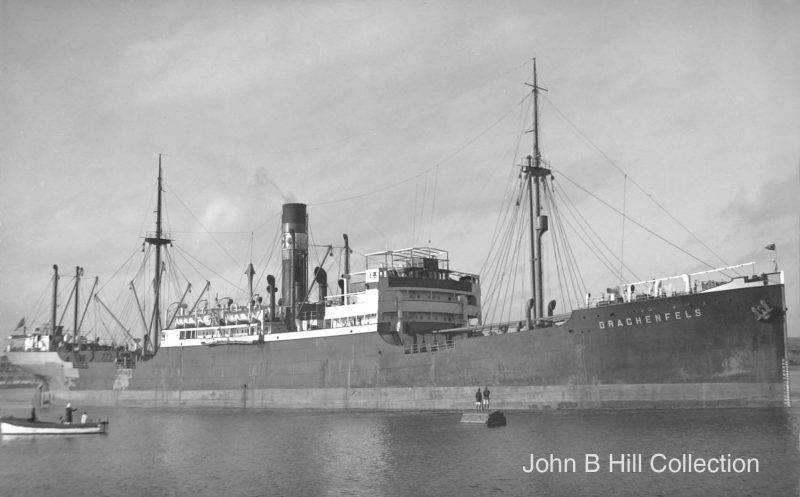
The first motorships were completed for the British register in 1912, while in Germany in the same year their first motorship was Rolandseck of 1,663 grt and 2,700 dwt. She was completed by J. C. Tecklenborg and her 1,500 bhp diesel engine produced a service speed of 11.5 knots. After four years of service with Hansa Line, she was sold to Portuguese owners and renamed Mira, but was lost by collision off the Portuguese coast on 26th November 1916.
Frienfels of 5,649 grt was a typical example of the Hansa Great War fleet, completed in 1910 by Joh. C. Tecklenborg of Geestemunde in 1910 with a deadweight of 8,705. She had dimensions of length 421.2 feet by moulded beam of 55.1 feet with a draft of 25.0 feet and her quadruple expansion steam engines were installed by the shipbuilder. She was captured and seized by Britain in 1914 as one of six German prize ships, the others being Braunfels, Frankenfels, Kurmak, Rotenfels and Werdenfels. The latter ship was captured on 1st August 1914 at Port Said by the British and later renamed Hunstanton. She was torpedoed and sunk by UC30 on 4th April 1917 when 36 miles west of Sicily Islands while on a voyage from Geelong to London with wheat, all of her crew were rescued.
However, the most famous of the Great War Hansa fleet was Wachtfels of 5,809 grt, which was launched on 8th March 1913 by the Flensburger Schiffbau yard and then commissioned into the German Navy on 16th May 1916 as the commerce raider Wolf. During 21 months of a successful worldwide voyage, she destroyed 35 merchant ships and two warships with her six 5.9 inch and three 2.0 inch guns and four torpedo tubes. She laid 450 mines in the main shipping channels of the world including off the South Australian coast, and returned to Kiel triumphantly on 24th February 1918 after 451 days at sea. She had a full cargo of captured rubber, copper, zinc, brass, silk, copra, cocoa and foodstuffs taken from her prize ships. Schneefels of 5,832 grt was her sister from the Flensburger Schiffbau yard and was launched on 13th November 1913 and completed six weeks later, but was captured shortly after the outbreak of war off Gibraltar by the Royal Navy and served as a water carrier and ship store in the Eastern Mediterranean and in the Dardanelles campaign. She was renamed Polescar in August 1916 as a general cargo ship and survived two U-boat attacks and a bombing at Dunkirk to be sold to the United Steamship Company of New Zealand in 1919 as Wairuna.
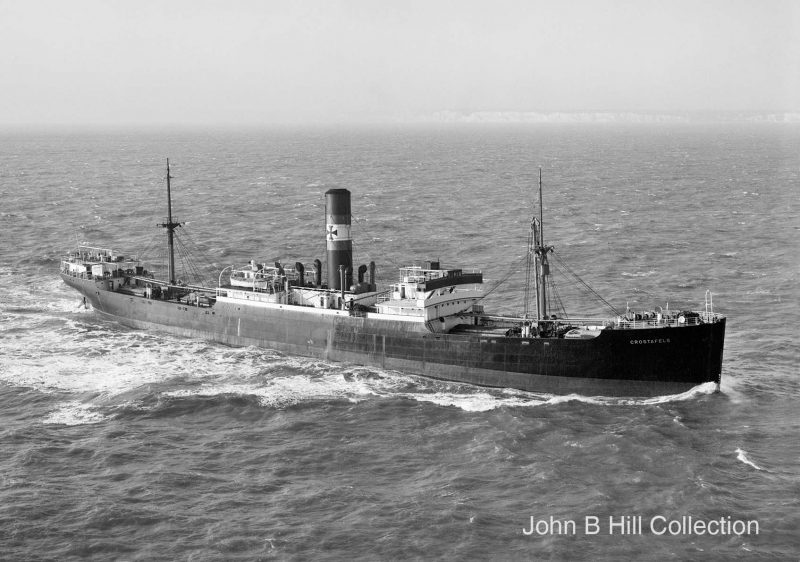
The entire Hansa fleet of 81 ships of 437,489 grt was lost during the conflict with only the small vessel Sonneck left to resume a short sea service to Spain in August 1919. The Treaty of Versailles in 1919 had confiscated any surviving German merchant vessels and they were given as compensation to the victorious Allies. Five prize vessels surrendered to the British Government were sold on to British shipowners, with Geierfels, Weissenfels and Rudelborg becoming City of Bagdad, City of Auckland and City of Westminster for Ellerman, while Treuenfels became Perim of P. & O. One surrendered vessel came back to the ‘Hansa’, this was Wolfsburg of 10,020 dwt, which was managed by Elder Dempster until sold to ‘Hungry’ Hogarths of Glasgow and renamed Baron Lovat in 1920, but returned to the ‘Hansa’ again when purchased back six years later. The Treaty of Versailles also forbade German shipping companies from resuming deep sea trading until after 1920, and some memorable big steam and diesel powered ships were then built for the ‘Hansa’. The service to the Plate was abandoned, but the service to Brazil continued until 1932 and the services from Europe and the U.S. Eastern Seaboard to the Persian Gulf and India were stepped up.
Several new steam powered cargo ships were completed by German yards in 1921/22 of up to 9,200 dwt, with three ships purchased from Prince Line of North Shields in 1925 and renamed Rheinfels, Sonnenfels and Stolzenfels. Six new motorships of up to 12,000 dwt were completed by the German yards of Vulcan Werke, A.G. Weser, Deutsche Werft, and Joh. C. Tecklenborg during 1925/27. Three were exact twin screw sisters powered by twin six cylinder four stroke single acting diesel engines as Neuenfels, Schwarzenfels and Weissenfels, while eight or six cylinder two stroke direct acting diesel engines were installed in the other single screw trio of Altenfels, Braunfels and Rotenfels to give service speeds of twelve knots. Trade began in 1922 with the Arab States of the Persian Gulf, and this helped the company weather the Great Depression of the 1930s.
Four sisters equipped with 120 ton heavy lift derricks on the foremast were completed during 1929/31 by the Deutsche Werft yard as the steamers Lichtenfels, Freienfels, Geierfels and Uhenfels. They were built for the demand of transporting German built locomotives to the Persian Gulf and India and had clear forward decks for lifting using spreaders into the holds and as deck cargo. They had dimensions of length 526.4 feet, moulded beam of 62.2 feet, and draft of 27.9 feet and a deadweight of 10,500 tons, with service speeds of 13.7 knots from triple expansion steam engines and a low pressure turbine. This quartet belonged to that early pioneering type of heavy lift ships that included the ‘Belships’ of Christen Smith of Norway. However, the ‘Hansa’ fleet was badly affected by the Great Depression of the 1930s with nineteen ships laid up.
The Hansa fleet on the outbreak of World War II was a big one of fifty ships and included some powerful new motorships of the Goldenfels class that could be used as commerce raiders. This fleet were predominantly sailing to the Persian Gulf and India, with seven ships in Geierfels, Rauenfels, Trautenfels, Goldenfels, Freienfels, Kybfels and Tannenfels sailing on a weekly service to Karachi and Bombay. Treuenfels, Neidenfels, Kandelfels and Ehrenfels made a fortnightly service to Colombo, Madras and Calcutta, while monthly sailings to Tuticorin, Rangoon, Coconada, Vizagapatnam and Chittagong were maintained by Rotenfels, Birkenfels, Treuenfels and Sturmfels. H. D. Ahlers & Company were the loading agents for both the Persian Gulf and Indian services, with offices in Hamburg, Teheran and Bombay, and the outward loading ports were Hamburg, Bremen, Rotterdam, Antwerp and Le Havre. There was also a monthly service between the U.S.A. and the Persian Gulf, and a bimonthly service between the U.S.A. and South and East Africa.
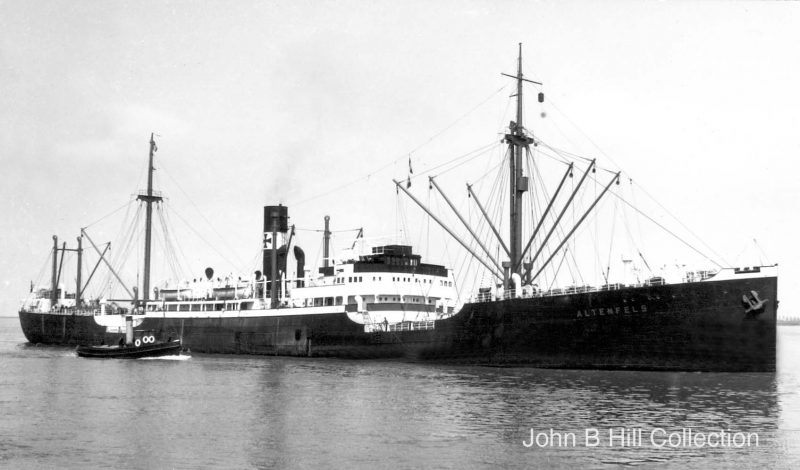
The commerce raider Atlantis was in fact the cleverly disguised ‘Hansa’ motorship Goldenfels of 10,340 dwt completed in 1938 by the Bremer Werft yard. She was commissioned in November 1939 under the command of Capt. Bernhard Rogge, who continually altered the profile of his ship by adding one or two masts or deckhouses and using different colours of paint to change the funnel colours, and also her name to disguise her as Norwegian and Swedish ships. She was built with two masts and four sets of posts and had twenty derricks, so it was relatively easy to change her profile. Atlantis sank 22 ships in a two year sortie of destruction until she was sunk in the South Atlantic by the cruiser Devonshire on 22nd November 1941.
Her sister Kandelfels was commissioned on 6th February 1940 as the raider Pinguin under the command of Capt. Felix Kruger, and sank fourteen merchant ships and captured three whale factory ships and eleven catchers in the Antarctic in a fifteen month sortie.
She was sunk on 8th May 1941 in the Indian Ocean by the cruiser Cornwall after Pinguin had sunk the tanker British Emperor the day before. The frantic signals from the tanker were picked up by Cornwall some five hundred miles away, and her new disguise as a Norwegian merchant ship did not fool the British cruiser. Tannenfels was also used as a supply ship to these nine disguised German commerce raiders, labelled raider ‘A’ to raider ‘J’ by the Royal Navy.
Ehrenfels had been blockaded into Portuguese Goa by early 1943, and was using her radio to transmit the sailing dates of over a dozen British ships from Bombay to U-boats waiting to sink them in the Mozambique Channel.
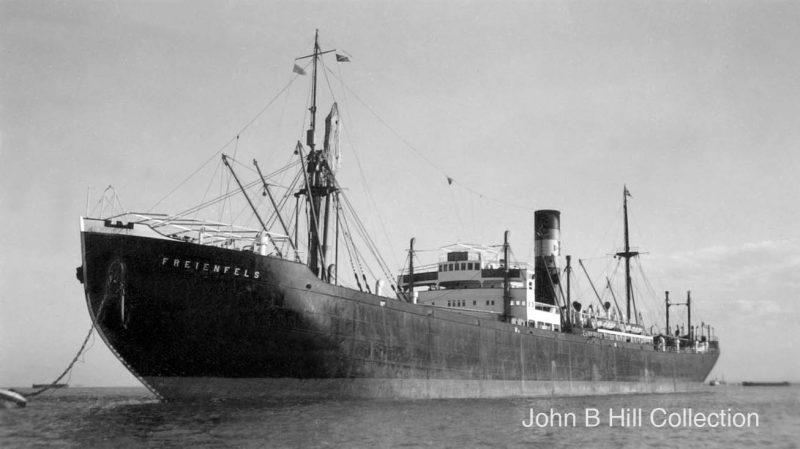
The Calcutta Light Horse regiment of elderly British officers sailed onboard a barge from Calcutta to Mormugao, and boarded and detonated explosives in the radio room of Ehrenfels in early March 1943. An open radio message was announced by the British Government in Delhi that they were about to invade Goa, which was a bluff. Ehrenfels, Braunfels and Drachenfels and several Italian ships in port scuttled themselves to prevent their capture.
The heavy lift ship Lichtenfels was blockaded in the Italian Eritrea port of Massawa along with Liebenfels and Wartenfels and seven other German merchant ships for eighteen months. She was scuttled on 4th April 1941 along with other German and Italian merchant ships in an effort to block the use of the harbour. Uhenfels, her sister, was sunk as Empire Ability after being captured by the destroyer Hereward and taken to Freetown, on 27th June 1941 by U69 in convoy SL78 when two hundred miles south east of the Azores. The other two heavy lift sisters, Geierfels and Freienfels, were both sunk by mine on 19th December 1940 off Leghorn.
The smaller Hansa Line cargo ship Soneck of 2,191 grt was completed by the Deutsche Werft yard in 1938 and was impounded by the Netherlands Navy ship Java on 10th May 1940 and was then operated by the KPM in the Dutch East Indies as a train ferry, before escaping to Australia. She served as Karsik under American forces and crewed by KPM crew members in the Pacific and survived the war.
The Helms family had lost all of their ‘Hansa’ ships during the war, and were prevented from regaining their overseas trades until 1950 by the Allies. Coastal towing of barges and raising of the many sunken war wrecks was however allowed. Split superstructure five hold cargo ships were purchased including three ‘Empire’ ships of 10,000 dwt, and pre-war cargo-liners were purchased from T. & J. Harrison as Tactician and Strategist, renamed Crostafels and Schonfels. By 1957, the ‘Hansa’ liner fleet had grown again to 44 ships, including engines aft types with their bridge forward above the fo’c’stle.
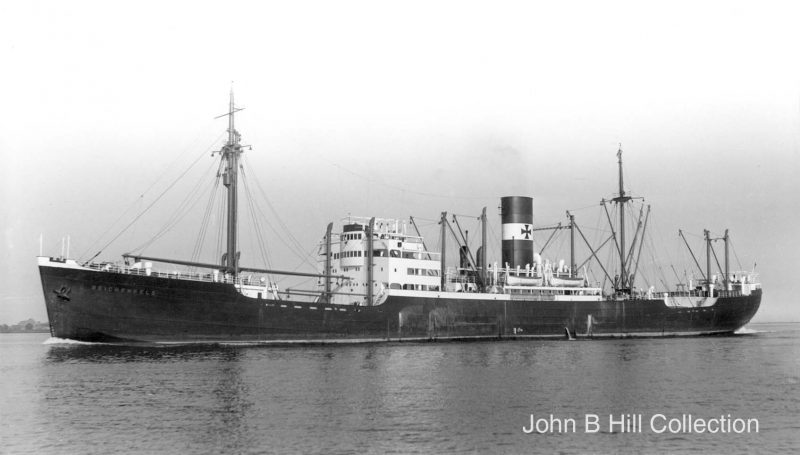
These included Barenfels, Birkenfels, Braunfels, Goldenfels, Gutenfels, Kandelfels, Kybfels, Lichtenfels, Liebenfels, Lindenfels, Marienfels, Neidenfels, Neuenfels, Ockenfels, Rabenfels. They were used in the heavy lift trades to the Persian Gulf, India, Pakistan, Ceylon and Burma, including locomotives and oil related equipment.
SPECIALIST HANSA LINE HEAVY LIFT SHIPS
A design had been prepared for a specialist heavy lift ship in the early 1950s by the H. C. Stulcken yard at Hamburg with six berths and able to build ships up to 492 feet in length. The Arab leaders of the oil rich Persian Gulf States made big investments in infrastructure in the 1950s in an attempt to achieve the economic level of the Western industrialised countries, and this favoured the ‘Hansa’ for the transport of very heavy oil related equipment. The Stulcken mast consisted of two tall tapering masts angled outwards, allowing the derrick to swing and serve the hatches both forward and aft of it. The patented Stulcken heavy lift derrick could easily lift up to 130 tonnes, and when two of these derricks were positioned above the clear long hatches, as in Spitzfels, Trautenfels and Treuenfels of 1958/59, lifts of up to 260 tonnes could be made. This trio of ships had three holds and three hatches. Lichtenfels, Liebenfels and LIndenfels were the first to be fitted with Stulcken heavy lift derricks of 140 tonne capacity in 1955.
All subsequent Hansa cargo-liners were fitted with Stulcken masts and derricks, and the ‘W’ class of Werdenfels, Wachtfels, Wallenfels, Wildenfels, Wasserfels and Weissenfels of 1962 had these heavy lift masts able to move along the deck of the ships to make loading and unloading of bulky items easier. The ‘champion’ heavy lifter of the fleet was Uhenfels, commissioned in 1959 by the A.G. Weser yard at Bremerhaven with only a fifty tonne derrick and twenty smaller derricks, but updated in 1967 with two Stulcken masts of a much heavier lift capacity of 275 tons each, and thus when used in tandem gave a lift capacity of 550 tons. This was an unheard of lift capability at this point of time. The bridge of Uhenfels was not above her fo’c’stle, but instead was aft of number two hold and hatch, with number four hold and hatch aft of the long main number three hold. She was tested to 10% above her 550 ton lift capacity at the Blohm & Voss yard by lifting heavy barges.
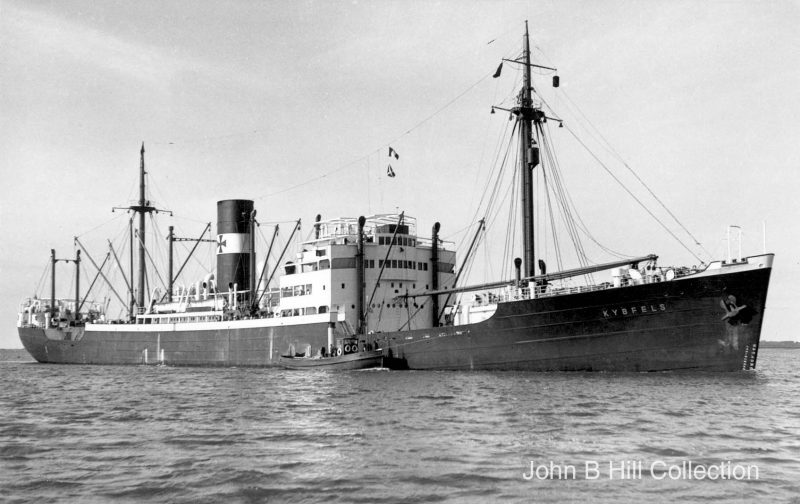
SOME OF HANSA LINE HEAVY LIFT SHIPMENTS
Uhenfels
- 1 pax ferry, 265 tons and 2 tugs, 264 tonnes, Germany/East Pakistan
- 1 atomic reactor, 350 tons, Holland/Spain
- 1 atomic reactor, 380 tons, U.S.A./Bilbao
- 1 stator, 330 tons, U.S.A./Cartagena (Spain)
- 4 heat exchangers, 275 tons each, U.S.A/Libya
- 1 tug, 145 tons, Rotterdam/Ras al Kafjii (Kuwait)
- 1 tug, 290 tons, Germany/Warri (Nigeria)
- 1 barge, 275 tons, Cherbourg/Cambodia
- 1 passenger ferry, 310 tons, Cherbourg/Cambodia
Treuenfels
- 1 motor tug, 250 tons, Holland/India
- 10 locomotives, each 170 tons, Germany/Liberia
- 2 ferry boats, each 245 tons, Germany/East Pakistan
- 1 pressure tower, 242 tons, France/U.K.
- 1 pressure tower, 220 tons, France/Holland
Kybfels

- 1 dock gate, 145 tons, France/Fort de France
Braunfels
- 1 cracking tower, 161 tons, Germany/Saudi Arabia
Weissenfels
- 1 barge, 148 tons, U.S.A./Liberia
Mariaeck
- 1 atomic reactor, 550 tons including beams and trailers, Holland/Sweden
Various heavy lift vessels
- 8 tugs, each 275 tons, Germany/Burma
- 35 tank barges, each 150 tons, Germany/Burma

Hansa Line heavy lifters also loaded in New York for Suez, Jeddah, Port Sudan, Djibouti, Aden, Persian Gulf ports, Karachi, Bombay, Colombo, Madras, Calcutta and Rangoon. The ‘champion’ lifter Uhenfels loaded several U.S. Navy tank landing craft, heat exchangers, elderly steam locomotives, oil cooling towers and oil related equipment etc.
OPERATIONAL CAPABILITIES of the HANSA HEAVY LIFTERS
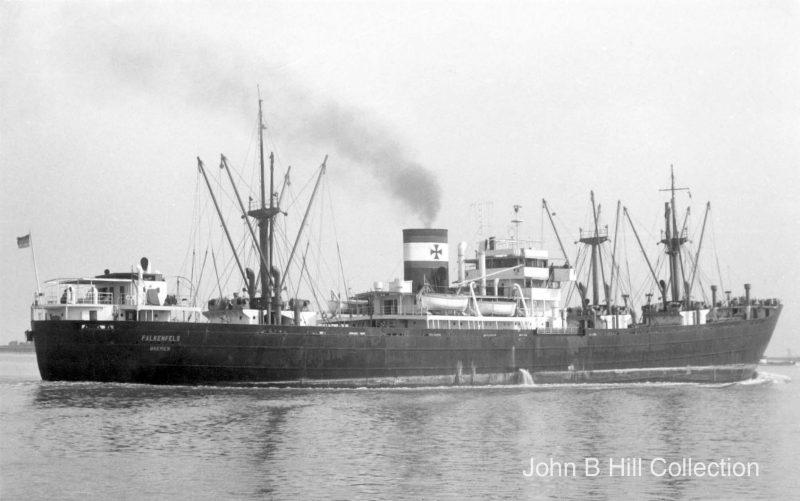
The ‘super’ Hansa heavy lifter of Uhenfels could handle the largest pieces of industrial equipment of 550 tons in the world, eliminating costly re-assembly in the country of destination. Her derricks had an outreach of 19 feet six inches over the side of the vessel with maximum load, but even more if the derricks were not being used to full capacity. The hatches were 115 feet five inches long, and the free deck length was 318 feet, and due to her special side ballast tanks she could handle the biggest lifts of 550 tons at a draft of only 23 feet of water. The Stulcken derricks of three next heaviest lifters in the fleet, Spitzfels, Treuenfels and Trautenfels at 260 tonnes, had an outreach of 19 feet six inches and even more if the derricks were not being used to full capacity. The maximum length of their hatches was 109 feet two inches, and they were ideal for lifting heavy transformers, barges, tugs and locomotives.
The equipment for heavy lift ships of this big lift capacity of 550 tons required numerous technical additions, especially several additional water ballast tanks, and other water tanks and pumps, to ensure that when the ships are empty no solid ballast needed to be taken onboard. As the lift proceeds on one side of the vessel, powerful pumps transfer water ballast to the other side of the ship to maintain stability. These modern ‘Hansa’ heavy lifters were equipped with all necessary spreaders, diagonal and longitudinal crossbeams for especially bulky shipments, as well as the especially designed ‘Hansa’ lifting mats and slings that were deployed at each end of cylindrically shaped project cargo to avoid damage to these expensive items.
The most important link in the lifting expertise, however, was in the special experience of the Lift Master, Navigating Master, Officers and crews in the loading, transport and unloading acquired over a period of many years. These men safely transported extremely heavy goods after a period of careful planning of where to place the various heavy items on the deck or in the hold. They simplified a loading task which to many onlookers on the quay next to the ship or a nearby vantage point seemed highly dangerous, and then safely transported the goods through storms, and repeated the same procedure to unload them all safely at their destination.
TWO RO-RO HANSA HEAVY LIFTERS
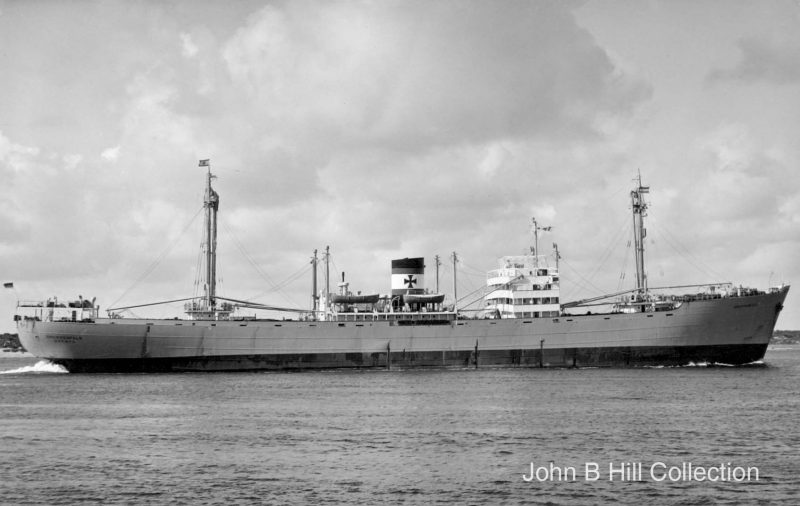
The ‘Hansa’ entered the ro-ro heavy lift trade with Mariaeck and Brunneck of 1,100 dwt in 1968. The sisters were able to load, transport and unload heavy lift items of up to 600 tons in weight and 249 feet in length from either the bow or the stern ramps. These heavy lift pieces could be carried either on the main deck or in the single hold, which had a height of sixteen feet eight inches. The low draft ranged from five feet seven inches to nine feet four inches, and varied in accordance to the weight being carried. The sisters could thus load at main ports, small river sites well inland, or even from open beaches in the most unpromising and unfavourable of positions with only a rudimentary ramp up to the bow or stern, up which land based pusher units could push these outsize items on to the upper deck or into the long main hold.
Alternatively, for smaller items, the sisters used their own hydraulic jacks to raise or lower the heavy lift items after the delivering trailer was replaced by a trailer belonging to the ship. The cargo was then lashed securely for transport with unloading carried out by moving out from the other end of the ship from which it was loaded. Part of their side rails could be removed so that cargo operations could also be carried out over the sides of the vessels. Brunneck loaded two gas tanks each weighing 224 tons and placed them just aft of her thin navigating bridge on the starboard side. A proposal to fit them with two heavy lift derricks each of 80 tonnes to give a combined lift of 160 tonnes was never carried out.
DIVERSIFICATION
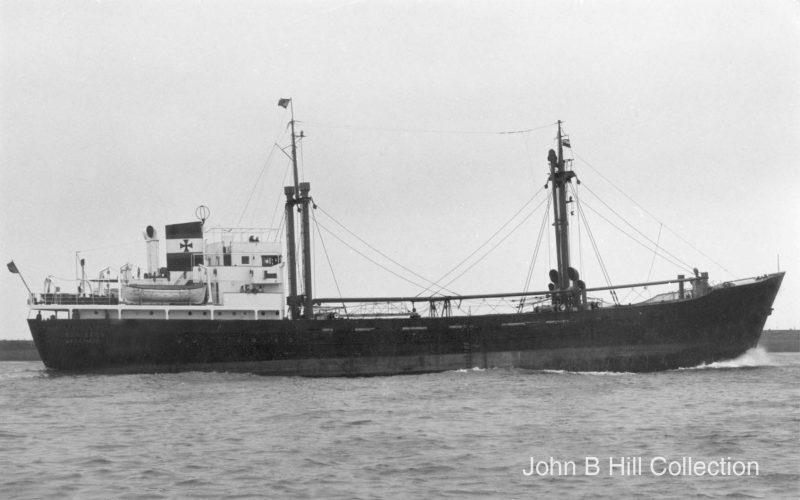
The first offshore oil rig supply ships were commissioned in 1965, and a separate division as Hansa Offshore was created three years later. These supply ships included Arsenturm, Fangturm, Imkenturm, Jakobturm, Johannisturm, Martiniturm, Michaelisturm, Nicolaturm, Pagenturm, Pauliturm, Petriturm, Schildturm, Steinturm, Warturm, Wilhaditurm with the last two completed in 1979 as Adamsturm and Lubeckertor.
Three ‘G’ class semi container ships of 11,888 dwt and 473 TEU capacity were completed by the Lubecker Flenderwerke yard as Goldenfels, Gutenfels and Geierfels for a charter to the newly formed Atlantica Container Line spA of Italy in a consortium with Villain & Fassio of Genoa, and later joined by Chargeurs Reunis of France in 1972. The ‘Hansa’ trio were renamed as Atlantica Montreal, Atlantica New York and Atlantica Livorno, and ran between Genoa, Naples, Marseille and New York, Boston and St. John’s, expanded with Atlantica Genova of Villain & Fassio and Atlantica Marseille of Chargeurs Reunis to include Barcelona, Lisbon, Baltimore and Norfolk (Va). In September 1974, their charters to Atlantica Container Line spA were cancelled, and the trio returned to Germany for lengthening and conversion into full container ships of 14,400 dwt. They had service speeds of twenty knots from seven cylinder two stroke single acting M.A.N. diesels of 12,250 bhp, and after the bankruptcy of Hansa Line at the end of 1980, this trio were ideal for sale or charter to big container fleets such as Hamburg Sud, Columbus Line, Torm Line, MSC and other top twenty container fleets.
The waste incineration trade was entered in the North Sea in 1972 with Vulcanus of 2,144 grt when purchased by the ‘Hansa’ and converted at the K.A. van Brink yard at Rotterdam. Tanks for transportation of the waste were added and two incinerators were placed aft, burning up to 500 metric tonnes of waste per day or 100,000 metric tonnes in a year. She also worked in the Gulf of Mexico on charter to Shell in 1974 to burn liquid chlorinated hydrocarbon wastes, and in 1977 in the Pacific on charter to the U.S. Government to burn the deadly left over stocks of Agent Orange from the Vietnam War.
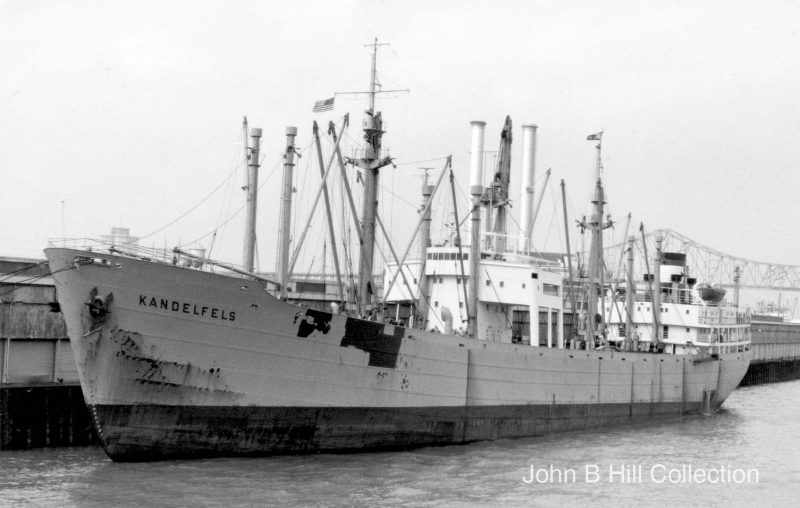
In the first half of the 1970s, the ‘Hansa’ invested large amounts of money in new heavy lift cargo-liners, sophisticated vessels with Stulcken and other types of heavy lift derricks. The ‘S’ class of Steinfels, Stockenfels, Stolzenfels, Strahlenfels and Sturmfels of 14,000 dwt were the best in the world, with Sturmfels also having the role of ‘Hansa’ training ship. In 1974, two recently completed general cargo vessels of 11,644 grt and 18,325 dwt were purchased from Karageorgis of Greece as Aristogenis and Aristokleidis. They were converted into heavy lift ships in 1975 by the Blohm and Voss yard at Hamburg, fitted with twin 320 tonne Stulckens and two pedestal cranes. They were renamed Trifels and Ehrenfels (renamed Trautenfels in 1976) respectively, and they were able to load crane barges up to 640 tonnes in weight when the Stulckens were used in tandem. By coincidence, this was also the maximum weight ever lifted by Uhenfels, when she loaded a 640 tonne atomic reactor at minimum outreach. In 1978, Trifels was rebuilt at Emden with an additional wheelhouse above her original wheelhouse and her holds two and three were reconstructed.
The ‘Hansa’ circumvented congestion problems in the Persian Gulf in the 1970s by using large ro-ros to berth at their fully owned terminals. Three red hulled ‘ConRo’ types were completed in 1977 of 14,181 grt and 15,075 dwt for the Europe to Persian Gulf trade. Two came from the Sasebo Heavy Industries yard in Japan and one from the Howaldtswerke yard at Kiel as Rauenfels, Reichenfels and Rheinfels. They were twin funnelled with a gantry crane, a large MacGregor stern ramp and two MacGregor sidepins. They were sold at the end of 1980 on the bankruptcy of Hansa Line to the U.S. Military SeaLift and painted grey all over and renamed Cape Taylor, Cape Texas and Cape Trinity.
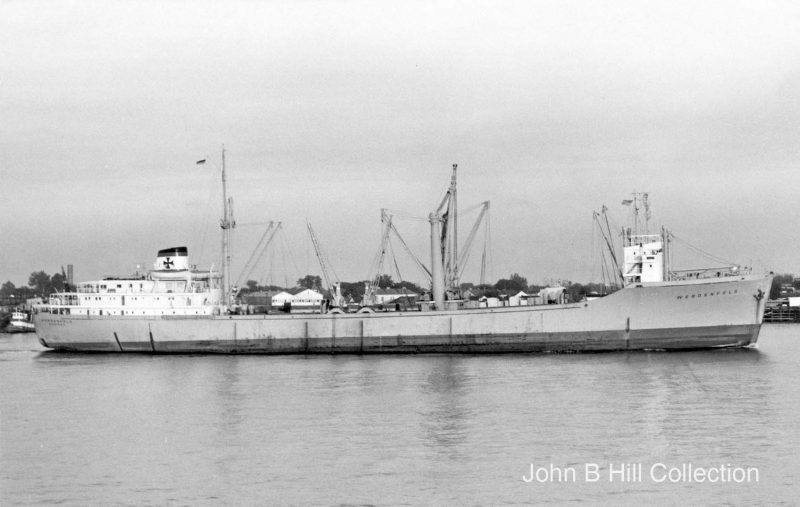
Stahleck of 1977 was an expensive heavy lift ship built at Bremen Vegesack that operated worldwide carrying heavy loads. She was twin screw and of 3,485 grt and 3,012 dwt, and had two heavy lift derricks positioned on the port side, each of 216 tonnes lift capacity or 432 tonnes when combined. She carried a lot of oil related equipment from Bremerhaven to Arzew in Algeria. During the late 1970s, the ‘Hansa’ was the largest heavy lift shipping company in the world. Uhenfels was sold on 22nd May 1978 to Greek owners and chartered back for a year, and continued to load German Navy minehunters and underwater research vessels at Columbus Quay at Bremerhaven and in Blexen Roads for Sandock Austral Ltd., Durban. The ‘Hansa’ fleet was engaged on the following voyages towards the end of 1978:-
- Brunneck: Sydney (NSW) to Kudamatsu (Japan)
- Goldenfels: Beaumont (Texas) to Damman and Ras Tanura
- Gutenfels: Philadelphia to Genoa and Dubai
- Mariaeck: Rotterdam to San Francisco via the Panama Canal
- Stahleck: Bremerhaven to Arzew (Algeria)
- Steinfels: Gdansk and Hamburg to Colombo
- Stockenfels: Hamburg to Genoa, Red Sea ports and Chalna (Bangladesh)
- Stolzenfels: Hamburg to Marseille, Red Sea ports and Aden
- Strahlenfels: Hamburg to Aqaba and Jeddah
- Sturmfels: Hamburg to Savannah and New Orleans
- Treuenfels: Hamburg to Chittagong and Calcutta
- Trifels: Hamburg to Kobe and Muroran (Japan)
- Uhenfels: Bremerhaven to Durban
However, the cost of this technically great fleet was very high, and by 1979 the ‘Hansa’ had financial troubles with attempts made to flag out the ships to cheaper registries. The loss of business in Iran in 1979 due to the revolution of that year was the final straw, and the Deutsche Bank and two insurance companies came to own 80% of the fleet. The ‘Hansa’ filed for bankruptcy on 18th August 1980 and the last heavy lift cargoes had been carried during the next three months, with the company ceasing operations on 31st December 1980. It was a sad end to such an enterprising shipping company, only one year short of its centenary. The ‘Hansa’ houseflag of white with red top and bottom and a central black iron cross was hauled down, and the black funnel with a black iron cross on a broad white band between two narrow red bands was painted over. The remaining ‘Hansa’ fleet was sold off to Greek shipowners, who simply changed the ‘f’ of ‘fels into a ‘b’ of ‘bels’, e.g. Uhenfels became Uhenbels for five years and continued heavy lifting e.g. oil loading buoys at Malta until she was broken up at Alang in 1985. The brand name of D.D.G. Hansa was sold in 1984 to Project Carriers and then on to Deutsche Seereederei of Rostock, operating as Interhansa A.G.
PRESENT DAY ‘HANSA’ SHIPPING COMPANIES
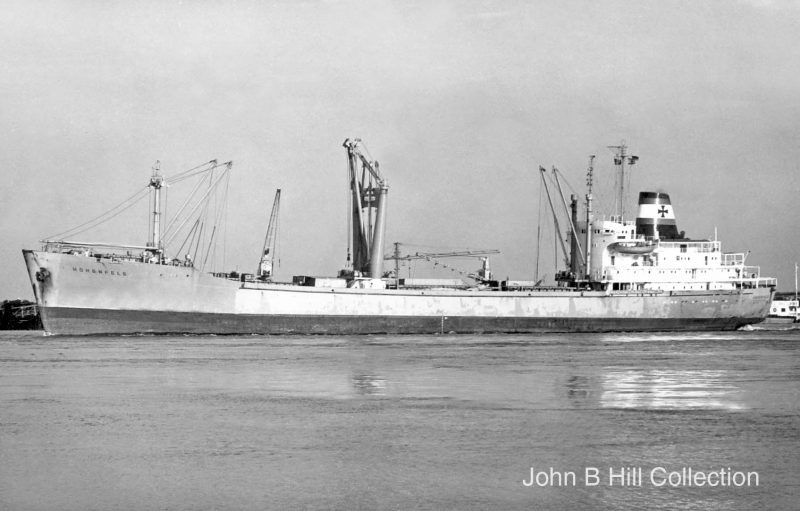
The mantle of the ‘Hansa’ shipping companies was taken up again in 1987 by the joint founding of a container ship charter company by traditional tramp shipping company Leonhardt and Blumberg of Hamburg and Hansa Treuhand A.G. (Hansa Trustees). The Hansa Trustees group was formed by Hermann Ebel in 1983 as a shipping, marketing and tourist company and owner of Sea Cloud Cruise ships Sea Cloud and River Cloud. Examples of charters were Ville de Saturne of 1,597 TEU and Ville de Mars of 1,799 TEU to CMA of France, and Brave Eagle, Fine Eagle, and Noble Eagle, all of 1,022 TEU, for Eastern Mediterranean services from Antwerp. Leonhardt and Blumberg are currently the largest owner of charter container ship tonnage in the range from 1500 TEU to 3,600 TEU capacity in the world.
Leonhardt and Blumberg (L & B) was founded in 1899 as Leonhardt and Heecht and purchased the first steamer Iron Prince from Prince Line of North Shields in 1901, renamed as August Leonhardt. Adolf Leonhardt was joined as a partner by Arthur Blumberg in 1903, and they built up a fleet of a dozen small tramp ships by the start of the Great War, the two largest being Frieda Leonhardt and Johanna Blumberg of 4,500 dwt, purchased at a joint cost of 880,000 German Marks. Their entire fleet was lost during the war including Myrza Blumberg of 6,000 dwt built by the Rickmers yard in Hamburg in 1909 as Mai Rickmers. Another large tramp shipping fleet was built up during the inter-war years after the death of Arthur Blumberg in 1922, with Adolf Leonhardt running the business by himself. Dry cargo tramps included Luise Leonhardt of 5,500 dwt, serving until she ran aground on 23rd November 1930 and was wrecked during a gale on the western point of Vogelsand while on a voyage from Hamburg to Searsport. Two steam tankers of 7,500 dwt were acquired in 1930 from Standard Oil Company of New Jersey, and they entered L & B service under the German flag as Lotte Leonhardt and Karl Leonhardt.
A fleet of eight dry cargo tramps of up to 8,700 dwt was owned on the outbreak of war in September 1939 and the entire fleet became war losses. The Allies prevented German shipowners from restarting overseas trading until 1950, thus L & B used Klaus Leonhardt of 889 grt, a former naval mine carrier, on coastal voyages from 1946. The first deep sea tramp was purchased from Larrinaga Line in 1950 as Miguel de Larrinaga and was renamed Bernd Leonhardt. A fleet of ten deep sea tramps had been built up by 1960, the two largest being the sisters August Leonhardt and Marie Leonhardt of 16,220 dwt. The tramp Bernd Leonhardt of 6,135 grt, completed in 1955, sustained severe damage in a collision with the American aircraft carrier Saratoga at the end of December, 1960. The entire navigating bridge, accommodation and funnel was crushed and mostly destroyed and had to be rebuilt at a cost of 4.5 million German Marks. A fleet of nine tramps and bulkers was owned in 1973 of up to 40,000 dwt, including three German ‘Liberty’ types, with feeder container ships then purchased for charter to Maersk Line. A fleet of four bulkers and thirteen general cargo ships was owned by L & B in 1986, shortly before their joint container ship charter operations were begun with Hansa Treuhand A.G.
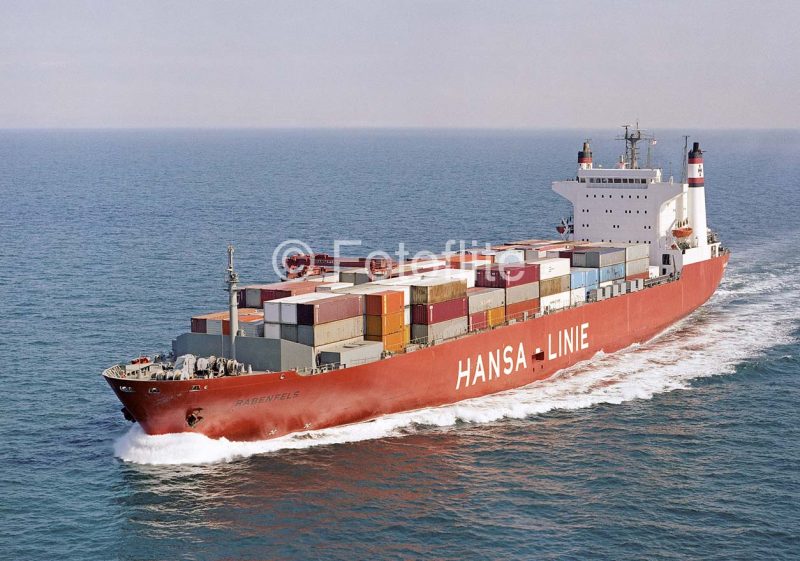
Four reefers of 12,950 dwt and 15,576 cubic metres capacity were constructed during 1989/90 as Hansa Bremen, Hansa Lubeck, Hansa Stockholm and Hansa Visby for charter to Cool Carriers. These ‘Hansa’ reefers had compartments allowing eight subdivisions of cold temperature between -30 degrees C and -12 degrees C, and carried 290 containers and were equipped with four deck cranes. They have been successful ships and served this ‘Hansa’ owner for over twenty years.
The container ship Hansa London of 1,014 TEU capacity entered service in 1992 as the first of six B183 type from the Stocznia Szczecinska yard and equipped with twin container handling cranes of forty tonnes capacity. Hansa Asia, Hansa Europe, Hansa America and Hansa Australia, all of 3,424 TEU capacity, were delivered in 1993 from the Samsung yard in South Korea, all flying the German flag. Hansa Riga of 1,645 TEU capacity was the first of eight container ships from the Hyundai yard in 1994, and Hansa Atlantic and Hansa Pacific of 4,565 TEU capacity were chartered to Maersk Line in 1995. The last two container ships completed by the Bremer Vulkan yard in 1997 joined the fleet as Hansa Century and Hansa Constitution of 2,810 TEU capacity. A team of naval architects from the Guangzhou Wenchong yard in China then worked with L & B staff to produce a design of a 1,550 TEU ship that resulted in a class of eight sisters built between 1997 and 2003, the first being Hansa Stavanger.
At the Millennium and based on the success of the 1,550 TEU design, a new design of 1,740 TEU capacity was delivered by Chinese yards, the first being Hansa Flensburg, the others being Hansa Lauenburg, Hansa Oldenburg and Hansa Sonderburg. The L & B centenary was celebrated in 2003 with the staff moving to a new headquarters office with a glass facade and overlooking the river at Hamburg. Hansa Europe of 3,600 TEU capacity was the first of four newbuildings from Shanghai Shipyard in 2012, she was equipped with four container handling cranes, and her diesel engines were electronically controlled.
Martini Chartering was formed in 2013 with F. Laeisz of Hamburg, and famous for their earlier fleet of ‘Flying P’ sailing ships. A bad fire on the chartered Leonhardt & Blumberg container ship Hansa Brandenburg of 1,740 TEU capacity on 17th July 2013 occurred when a container caught fire 200 miles north east of Mauritius. A forward cargo hold and the crew accommodation area were badly damaged while she was on a voyage from Singapore to Durban, her seventeen man crew were rescued by the passing container ship Donau Trader. The chartered ship was on charter to Pacific Interational Lines and arrived safely at Port Louis in Mauritius and temporary repairs were made.
Four Handysize container vessels of 1,740 TEU capacity were purchased in 2014 to increase the market share of the L & B, Hansa Treuhand and Laeisz fleet. Leonhardt and Blumberg have owned 180 ships ranging from small tramps to big container ships in their almost 120 years of history. At the start of 2016, the Hansa Treuhand fleet had 31 container ships of between 1,350 TEU and 6,500 TEU capacity including Hansa Liberty, Hansa Victory and Hansa Constitution. However, nine months later the company had half of its fleet laid up and had filed for court protection for these fifteen vessels, with 25% of its staff made redundant. There were over four hundred container ships over 500 TEU capacity laid up and idle worldwide at the start of 2017 with a huge scrapping programme underway of relatively young vessels. The demand for charter container vessels had collapsed.
Hansa Heavy Lift (HHL) was formed in 2011 from the bankrupted fleet of Beluga Shipping Gmbh, founded in 1995. Another present day ‘Hansa’ shipping company was founded in 1991 in Bremerhaven as Hansa Mare Reederei, a joint venture between Hanseatic Lloyd Reederei and Schlussel Reederei K.G., the latter founded in 1950. The container ships were given a ‘Mare’ prefix to their names e.g. Mare Adriaticum, Mare Africum, Mare Arcticum, Mare Atlanticum, Mare Brittanicum, Mare Balticum, Mare Caribicum, Mare Doricum, Mare Caspium, Mare Hibernium, Mare Ibericum, Mare Internum, Mare Ionium, Mare Lycium, Mare Phoenicium, Mare Siculum, Mare Superum, Mare Thracium, and Mare Tuscum. The fleet was chartered out to American President Line (APL), ANL, CMA CGM, Hapag-Lloyd, ‘K’ Line, Libra Line, Maersk Line, MSC, Pacific International Line (PIL), P. & O. Nedlloyd, TMM of Mexico, United Arab Shipping Company (SAG), Yang Ming Line and other big container fleets. The fleet had grown to a maximum of 20 ships in 2009, but had fallen back to only 9 ships by the end of 2016 due to a lack of demand for chartered container ships.
POSTSCRIPT
Small German sailing ships known as ‘cogs’ carried ‘Hansa’ cargoes for ‘Hansa’ merchants and towns for seven centuries on the Baltic and North Seas, using both fair and foul trading practices. In 1820, the first small German steamers were used on the Rhine to battle their way upstream against the fast currents, and a system of tugs and barges was assembled at Rotterdam for the transhipment trade into deep sea sailing ships. On 28th October 1857, the first German coastal steamer, Adler (Eagle), sailed on its maiden voyage to London, and by 1881 ships of the Adler Line, Carr Line, Hapag, Norddeutscher Lloyd, and Hansa Line were voyaging across the world on new commercial routes. Hansa Line had a reputation for heavy lifting of project cargo for fifty years between 1930 and 1980 that was second to none, with an unmistakeable profile of bridge forward and engines aft and massive lifting arrangements for their big fleet of heavy lifters.

Since the demise of Hansa Line in 1980, several German shipowners have carried on the ‘Hansa’ tradition of acting together, giving ‘Hansa’ prefixes to the names of their ships that continue to sail nine centuries after the ‘Hansa’ tradition was founded in Hamburg, Lubeck, Rostock and Bremen and other German ports.
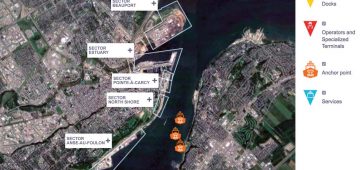



Comments
Sorry, comments are closed for this item